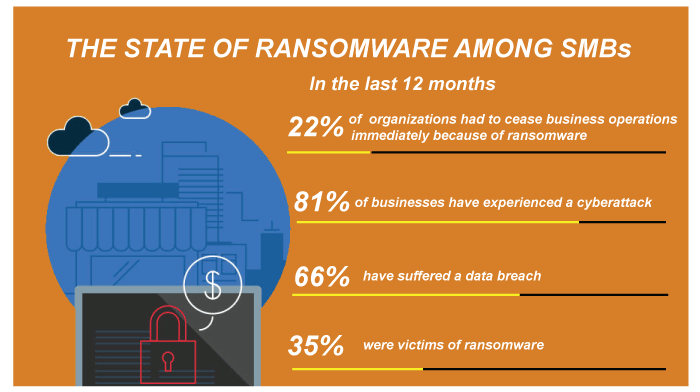What is Ransomware?Ransomware is a malicious software which infects many computers and displays messages demanding you pay a fee to get your system working again. The malware class is a criminal moneymaking scheme that is set up by an email message, instant messages or misleading links on the website. It locks a computer screen or encrypts predefined files with a password. History of RansomwareIn 2005, the first case was reported in Russia. Scams have spread around the world, with new types still targeting victims. In September 2013, CryptoLocker appeared and targeted versions of Windows. Ransomware successfully infected thousands of personal computers and business systems. The victims opened emails from FedEx, UPS, DHS and many companies implementing the customer support services. Examples of RansomwareScareware is also a type of Ransomware. It uses deceit tactics or intimidation to pay victims. A message suddenly claims that your computer has various problems, and online payment is necessary to fix it! Nevertheless, another type of Ransomware appears to be from a local law enforcement office by opening a page to a law enforcement agency and a computer user claiming he was caught doing illegal activities online. The files are locked into hard-to-crack, encrypted files, making it difficult for users to pay to recover. Attackers ask for $ 100 to $ 200. Other attacks are much wanted, especially if the attacker is aware that mortgage data can cause financial losses to the company to a large extent. The cybercriminals who set up these scams can earn significant sums. There is no guarantee that computer users will fully recover the system. While some hackers instruct victims to pay through bitcoins, money packs, or other online methods, attackers may demand credit card data, adding to the level of other financial losses. Types of RansomwareThere are 3 types of Ransomware, which are given below: ScarewareScareware is not as scary. It includes security software and technical support scams. In Scareware, we receive a pop-up message claiming that the malware was discovered, and the only way to get rid of the virus is to pay online. If you do nothing, you continuously receive pop-ups, but the files are almost safe. If you do not have the company's software on your computer, it will not monitor you for ransomware infection. Screen lockerUpgrade the Terror Alert Orange for these people. When lock-screen Ransomware is found on our computer, it means that you are out of your PC. If they suspect you of theft, child pornography or other cybercrimes, they will go through the appropriate legal channels. Encrypt RansomwareIt is dangerous stuff. These are the people who are snatching our files and encrypt them, demanding payment for decryption and redistribution. This type of Ransomware is so terrible because once cybercriminals pile up our files; no security software or system can restore or return it until you pay the ransom. And if you pay, there is no guarantee that cybercriminals will give those files back to you. Latest ransomware attack
How do ransomware targets?When Ransomware was introduced, its earliest victims were individual systems. Cybercriminals began to realize their full potential when they incorporated Ransomware into businesses. At the end of 2016, the global enterprise had 12.3 percent ransomware, while only 1.8 percent of consumer custody the Ransomware worldwide. And by 2017, 35 % of small and medium-sized businesses had experienced ransomware attacks. 
Ransomware reports on small and medium-sized businesses Ransomware is mainly focused on Western markets, with the top 3 countries ranking the United Kingdom, United states and Canada. As with other threatened actors, ransomware writers will follow the money, seeking wider PC adoption and areas with relative wealth. As economic growth in emerging markets in Asia and South America increases, Ransomware is expected to increase. What to do if we infected by Ransomware?If you find yourself infected with Ransomware, the first rule is to never to pay the ransom. (FBI-backed advice.) We have not to do anything that encourages cybercriminals to launch additional attacks against you or any other person. We may be able to retrieve some encrypted files using free decryptors. All ransomware families are not created decryptors for them. In many cases, because Ransomware uses advanced and sophisticated encryption algorithms. You do not further encrypt your files using the wrong decryption script. Therefore, we need to pay attention to the ransom message yourself or seek a security / IT specialist's advice before attempting anything. Another way to eliminate ransomware infection is to download a security product known to protect against threats and run scans. You cannot get our files back, but we can be sure that the infection will be cleared. For screen-locking Ransomware, an entire system restore may be in order. If it doesn't work, we can try running a scan of a bootable CD or any USB drive. If you ever notice slowing down your system for no reason, shut the system down fast and then disconnect it from the Internet. If you boot once again, the malware is still active; It will not send or receive commands from the control server. It means that without the key or method of withdrawing payments, more malware can remain inactive. At that point, download and install any security product and run a full scan. We often require many more excellent technical skills than the average computer user. How does Ransomware affect our business?GandCrab, SamSam, WannaCry, NotPetya-there are many Ransomware types, and they are hitting businesses hard. Ransomware rise 88% in the second half of 2018 as cyber-criminals stayed away from the attacks. Cybercriminals recognize extensive commercial translations to target large payouts, hospitals, government agencies, and commercial institutions, including the remediation, penalties, and ransomware payouts, which work out of $3.86 million.
Next Topic7-ZIP
|
 For Videos Join Our Youtube Channel: Join Now
For Videos Join Our Youtube Channel: Join Now
Feedback
- Send your Feedback to [email protected]
Help Others, Please Share









